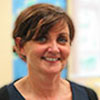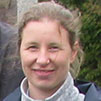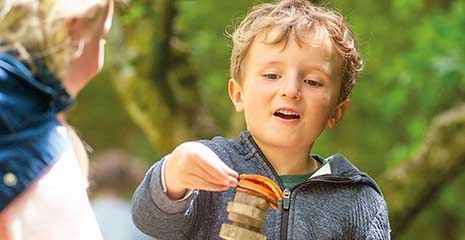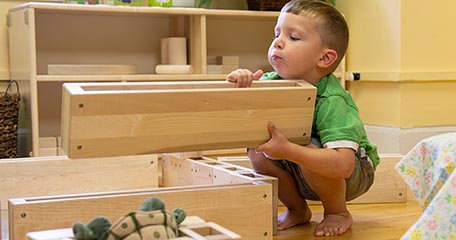The magic of blocks
Unlocking learning in Liverpool
| September 2016Children in the Liverpool area have been benefiting from an initiative to inspire learning through block play. Evelyn Vanderhoof from Community Playthings interviewed some of the people who have been involved with the Liverpool block play project.
Community Playthings: Can you tell us how the block play project got started in Liverpool?

I knew first-hand how creative children can be with the simplest materials. Couldn’t our children do the same? And with all its inherent discussion, working together and problem solving, I was sure block play would improve, not just creativity but learning in other areas as well. I realised that if I wanted children to have these learning opportunities, I needed to ignite practitioners’ interest in block play.
With some funding we had available for Quality Improvement Projects, we were able to provide ten settings with a set of Community Playthings Hollow blocks and a set of Unit blocks. We also provided a floor book and a Flip Mino camera to document observations of the children and adults interacting with the blocks.
I contacted Dan Spry in Cheshire West to see if he would consider supporting the Liverpool project by providing the training input. We were keen to include a blend of early years theory and educational research alongside practical experiences, distance learning tasks and discussion. As we devised a delivery plan together I realised the many benefits of working together and sharing ideas and expertise especially across Local Authorities.
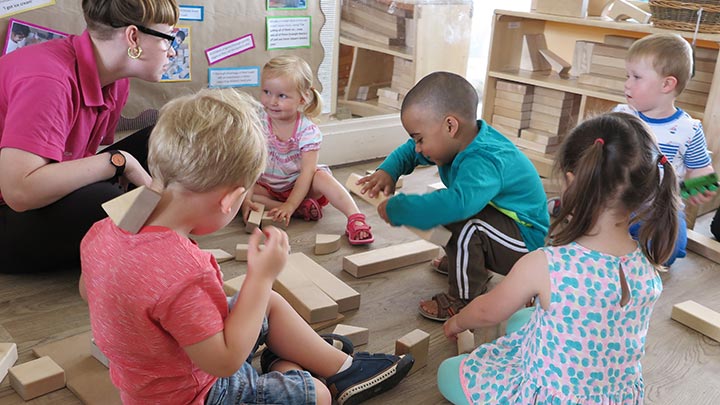
Community Playthings: How did you develop the training and what does it involve?

We developed a six-day training course. There are five taught sessions along with a setting exchange. We ask participants, in their own time, to buddy up with someone else on the course and visit their setting to see how blocks are being used there.

Colette: The floor book is useful to show parents what their children learn through block play. School inspectors have also been impressed by the practitioners’ research and how the children’s progress is documented.
The final session of each project is a Celebration Event, this creates an opportunity for the practitioners to present their research findings digitally alongside their floor books and celebrate their successes. This session also enables senior leaders and managers to learn more about the wider impact of block play on children’s learning and development.
Most of the practitioners had never been asked to present research before, but a number of them found the experience uplifting and rewarding. Others were able to use their presentations and floor books to support MA modules or interviews for promotion.
Community Playthings: Studies name Liverpool as having five of the country’s ten most deprived areas. How has this influenced your project?
Colette: To improve outcomes for our children we knew we needed to target communication and language development and personal, social and emotional development. Block play has been a great vehicle to help children who have communication difficulties and other special educational needs transition into settings. Because building with blocks is open-ended, there is no requirement to do things in a certain way. Through regular access children are able to develop confidence and the freedom to create their own learning.
Block play removes language barriers! For children learning English as an additional language, we found that through its universal access block play removes language barriers and enables children to communicate at their own level, demonstrating their ideas through representation. Through our local research we concluded that block play is fundamental to providing opportunities for children and adults to explore and demonstrate the characteristics of effective learning and teaching.

Community Playthings: Can you tell us any stories?
Lisa: I visited a setting where two children were creating London Bridge. They were looking at pictures of it and discussing what the bridge looked like and why they were building it. They estimated the length of the bridge, and talked about where they thought the legs of the bridge should go. I noticed their perseverance and thought about the characteristics of effective learning, especially when they were in the middle of building the bridge and it fell down. They straight away talked about how they could keep it from falling down again, and successfully rebuilt it. They could clearly articulate to me how they used a heavier block and a stronger material to keep it from dipping in the middle. I was also interested to see the role of the adult: the teacher took a step back. Though she gave support when it was needed, she let the children work through their problems together.
Kelly: We’ve got one little boy in our nursery with a communication delay. He has single words, but not many of them. One day we were outside playing with the Hollow blocks and he was trying to manoeuvre them. As he went to lift one, he turned to his key person and said, “It’s heavy!” That was just huge for us, to hear a word like that. He really meant it and knew the whole word. It was good, very good.

Community Playthings: What about writing and mark making? How can adults link this into block play?
Lisa: I think the role of the adult is to give the children the opportunity to talk about what they are doing as they build, possibly to draw plans, and then to start to bringing writing and drawing into what the children are doing.
Dan: Once the children construct their models, it’s difficult for them to knock them down and pack them away. It’s like taking a painting that a child has worked on and throwing it in the bin, disregarding the effort the child has put in.
We try to encourage practitioners to leave structures up, to celebrate them through taking photographs, and to get the children to label them so that when the cleaner comes in the evening, he knows not to tidy it away. We want practitioners to use their labelling as a way into writing, particularly for boys.
One Reception teacher was fascinated by this idea. She was there after school one day when the cleaner came in, and commented on how the boys had labelled their structures with squiggles.
The teacher said, “Oh, the children labelled them so you don’t knock them down and tidy them away.” Then she explained that it was a way of getting them to start mark-making.
The cleaner said, “I wouldn’t knock them down. I’d like to a bit know more!” So the teacher got the cleaner to write a letter back to the children saying, “I love your structures. Could you tell me more about them?”
This teacher had been teaching for quite a while and had always found it difficult to get the children to start writing, but by introducing it through a real person, the cleaner, whom the children saw around the school, they could now interact beyond the classroom. Suddenly, because of this letter from a very real person, the children’s writing shot off in amazing directions. The teacher was seeing not just labelling, but stories and almost technical drawings where the whole structure would be labelled and every component part named. Writing flourished in a way she had never seen before, and it came from that interaction between the cleaner and the boys who had labelled their blocks.
Community Playthings: Why have you focused on blocks and block play as being valuable learning when there is so much exposure to and emphasis on electronic devices for young children?
Lisa: I think it is very important that children have access to open-ended, natural resources, particularly when we are seeing a lot of electronic devices introduced to children. But I also see where they have a role together. Children can use electronic devices to research topics, to look at photographs and video clips, and then take these ideas into the block play area.
Colette: With an increasing emphasis on technology in the home, toys to support learning etc., I feel it’s really important to re-balance that with a medium for play that isn’t electronic. Block play should be an essential element of continuous provision, enhancing both indoor and outdoor learning environments in line with the EYFS. Although technology is very much a part of block play, it is the type which requires creative energy to provide learning outcomes.
Dan: I really do believe that block play gives you a practical understanding that can feed into a more technological understanding as you get older. My own son has used blocks from a very early age and recently has become quite engaged in Minecraft, which is a computer program where you build with blocks. For some of the designs he makes in the virtual world, he relies on his understanding from building it physically in the real world. There is no reason why he, as an adult, couldn’t become an architect or a designer. He’s got those two elements, the practical understanding and the technology to do it.
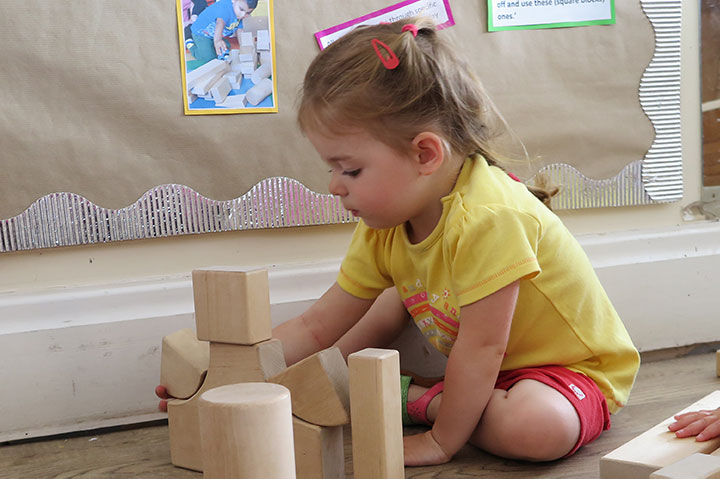
Community Playthings: Have you been able to use government funding for block play?
Lisa: With the introduction of the Early Years Pupil Premium, practitioners have asked us for advice about how to use it to support continuing professional development. Block play training is ideal for that. We have seen how it provides practitioners with research opportunities and professional development whilst giving them a key resource for the children in their settings, so it’s a really effective way of using the pupil premium.
Community Playthings: What would you say to other Local Authorities or governing bodies regarding the long term investment in buying blocks and providing block trainings for their practitioners?
Colette: For us, engagement in the Liverpool Block Play Research Projects over the last 6 years has enabled hundreds of early years practitioners to focus on an area of continuous provision that impacts holistically across all areas of learning and development. This in turn has enhanced pedagogical practice across the city as both new and experienced practitioners have discovered their potential for teaching, and children’s potential for learning, through block play.
Dan: Over the years that I have been involved in delivering block play training I have been in the fortunate position, with funding from the national government, to be able to give hundreds of block sets to practitioners. The benefits that I see to the children and practitioners in all those settings, preschools, and Reception and Year 1 classes, are amazing. It is unlike any other resource.
I would whole-heartedly encourage anybody to buy blocks. They are expensive, but they are an investment. We started this in 2010, and I still visit practitioners that were on the original course. Their blocks are played with daily, and they are in almost as good condition as when they were bought because they are so durable and wear so well. I would encourage everybody to buy blocks.




